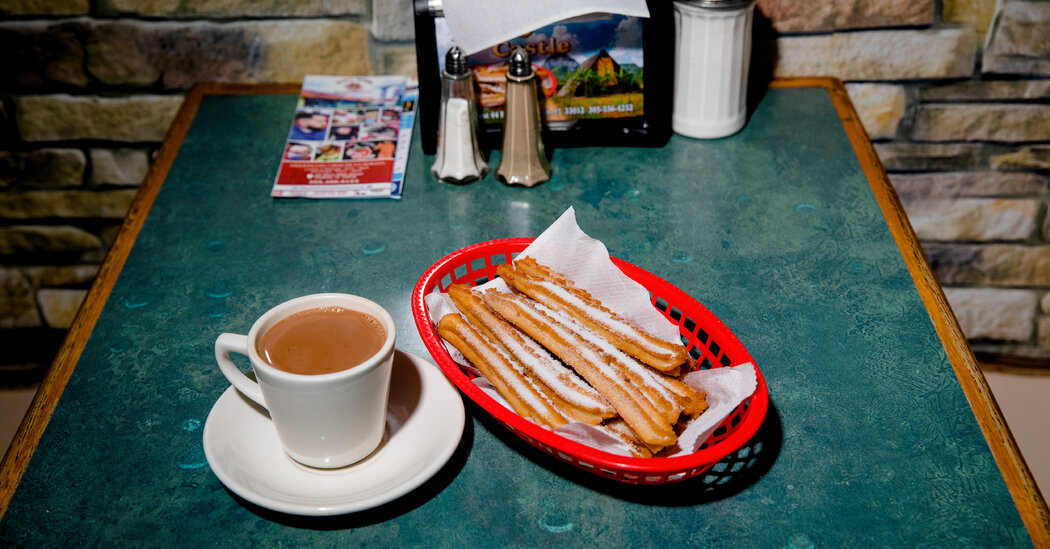The combination has roots in Spain — but here the union has a distinct Floridian flair.
MIAMI — Cold winter days in South Florida are rare and fleeting. But when the temperatures dip below 60 degrees, one thing remains constant: long lines for freshly fried churros and thick hot chocolate.
There are dozens of restaurants in the Miami area that serve churros all year, including some that focus solely on the treat, but winter is their biggest season.
Bundled up in fluffy jackets and furry boots, locals stand in long, winding lines in the cold to get their hands on something warm, said Arletty Hernandez, 21. “It’s a Miami thing,” she said, shivering, after picking up her churros from La Palma on Southwest Eighth Street.
At La Palma, which opened in 1979 and is owned by the family that runs Versailles Restaurant, hundreds of people line up in the chilly weather for the classic deep-fried churros sprinkled with sugar, accompanied by a dense, Spanish-style hot chocolate. The colder it gets, the more churros they sell. On an especially brisk night, staff can sell nearly 2,000, according to Nicole Valls, the owner’s granddaughter.
“When you move to Miami, besides learning about Versailles, you learn about La Palma for the winter,” said Nicole Rosario, 48, who made the last-minute decision to pick up churros on Sunday after she attended a wedding nearby.
Sara Manis, 63, braved the lines for churros on Sunday, something she’s wanted to do since she first saw a story years ago about it on the local news. “That was the first time I ever tasted it like that,” she said about the treat.
La Palma isn’t the only place with crowds. At Morro Castle in Hialeah, another old-school spot serving up churros all year, people can wait as long as 20 minutes to sit inside and buy churros for 20 cents apiece. The cafeteria-style restaurant, which opened in 1966, can sell as many as 3,000 churros when temperatures plunge, said Leo Villalobos, an owner and nephew of the restaurant’s founder.
The recipe — just flour, oil, water and salt — came from Cuba, where Mr. Villalobos’s uncle ran a restaurant. A friend built Morro Castle a pedal-operated machine to extrude the dough into its traditional fluted shape. The hot chocolate, also dense here, is made with two different milks, sugar, chocolate and cornstarch, the key to its thickness.
“It’s kind of like a hand-me-down tradition,” Mr. Villalobos said about people seeking the treat during the wintertime. “It’s something that’s been going on for generations and they brought you as a child, and they bring their children and grandchildren.”
This Miami ritual has roots in Spain, where the churros-and-hot-chocolate combination is typically served as breakfast, said Maria Paz Moreno, a professor of Spanish at the University of Cincinnati and author of “Madrid: A Culinary History.” She has traced the churro’s lineage back to a cookbook written in Arabic that dates back to the 13th century for a dough made with flour and water fried in oil, but it wasn’t called a churro yet.
Another cookbook — which she considers the “Bible for Spanish cuisine” — dates to 1611 and was written by Francisco Martínez Motiño, who cooked for the King of Spain. It has a recipe for churros, which Martínez Motiño called “fruta de sartén,” or fruit of the frying pan, Dr. Moreno said.
The term churro was not used until 1884, according to the Real Academia Española, an organization that preserves the Spanish language, said Sarah Portnoy, a Latinx Food Studies professor at the University of Southern California, Dornsife, and the author of “Food, Health, and Culture in Latino Los Angeles.”
Churro, Dr. Moreno said, comes from the sound the dough makes when it hits the hot oil.
As for the dense hot chocolate, Spaniards took that from the Aztecs in Mexico. The Aztec version was a thick drink, made with cacao, that was bitter, thickened with corn and spiced with chiles, Dr. Moreno said. The Spaniards made it palatable to their taste buds by adding sugar and vanilla.
Like many dishes throughout Latin America with Spanish influence, churros were adapted in many countries. “You find people putting different flavors into tamales these days or empanadas,” Dr. Portnoy said. “Over time, with globalization, flavors adapt and evolve.”
The owners of Santo Dulce, which serves churros, hot chocolate and ice cream at several Miami locations, did not want the restaurant to serve just one type of churro, said Laura Luque, who is from Colombia. She owns the business with her wife, Yule Nuñez, who is from Venezuela. Along with the classic cinnamon sugar churro, they also have a variety of other flavors like guava and cheese, dulce de leche with coconut, and maple with bacon.
Santo Dulce does most of its business in winter. Just last week, when the temperature dropped into the mid-50s, people were waiting in line for more than an hour, and yes, people even then still ordered ice cream and milkshakes. This weekend temperatures may drop to the 30s.
“Everyone goes nuts,” Ms. Luque said.
Recipes: Churros | Mexican Hot Chocolate


























